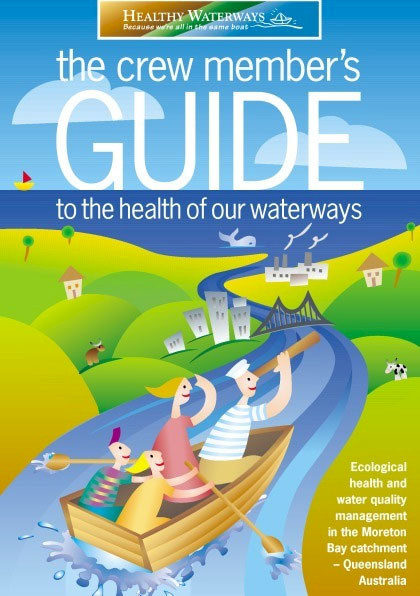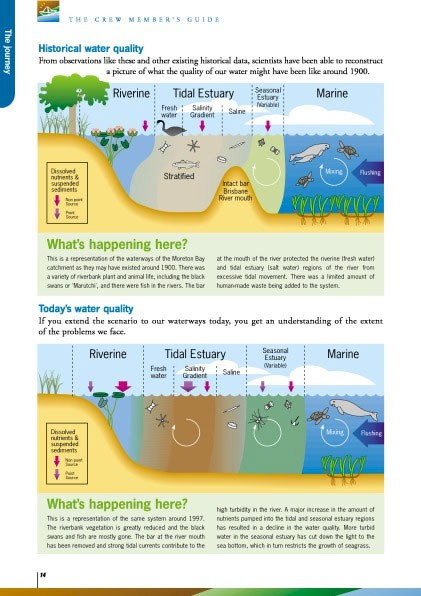The crew member's guide to the health of our waterways
Bill Dennison ·The crew member's guide to the health of our waterways is now available for free in PDF format from IAN Press.

This short book (~100 pp.) was the first of a series of four books produced as part of the Healthy Waterways campaign in Southeast Queensland. It was published in 1998 and was a key component of the campaign in a variety of ways. First, the book was inexpensively priced to encourage wide dissemination. Catchment groups could purchase the book for half price, sell it for full price and retain the profits to support their fledgling efforts. Second, this book provided the broad contextual framework for Moreton Bay and the major tributaries, using conceptual diagrams, maps and photos to depict the key features and major threats of each subregion. Third, the 'Crew guide' was the first publication of an ecosystem health report card for the region. This first report card was very qualitative and subsequent monitoring and assessment created a rigorous, quantitative report card. Fourth, the book featured various community leaders, with photographs and short testimonials in 'catchment comments'. Fifteen years later, people have moved into different roles (or in the case of Peter Oliver, passed away), but their key contributions are captured with these profiles. Fifth, we scurried around as the book was going to press to include an introduction to the cyanobacteria (blue-green algae) blooms of Lyngbya. Finally, each local council provided accounts of the various activities that they were engaged in that affected the waterways, which seem somewhat modest by today's standards. Yet, at the time, it was a revelation that so much was actually happening, which served to empower the councils and helped create momentum for the campaign.

At this early stage of the Healthy Waterways campaign, we did not have good maps or diagrams, and a limited number of photographs. So looking back at this publication 15 years later, the quality of the conceptual diagrams and maps provides a 'cringe factor'. Yet, the overall 'call to action' still resonates today and the range of healthy to degraded ecosystems was a sound assessment. I particularly enjoy the photo of the first research boat, Warrajamba, that our University of Queensland Marine Botany group used to study the bay (pp. 24-25).
One of the important aspects of developing a vision for Healthy Waterways, and in fact, the term 'Healthy Waterways' itself originated from the overall conceptual diagram (p. 14). We compared the historical vs. current conditions to depict the transitions that had occurred which allowed us to start charting a future vision. The color scheme on the Healthy Waterways logo was derived from the conceptual diagram as well. I had forgotten that we used a comparison with Chesapeake Bay, also depicted as a conceptual diagram to contrast with Moreton Bay (p. 73).

I once used this book as a prop in a national review panel site visit to Brisbane. We had already published 'Moreton Bay and Catchment', a large, heavy black & white tome of scientific papers on Moreton Bay. The contrast of 'Moreton Bay and Catchment' with the small, short and colorful Crew Guide was marked. So I dropped 'Moreton Bay and Catchment' on a table from several feet above, and remarked that it produced a sufficient thud. I then contrasted the lack of a thud by the Crew Guide, but added that 'Moreton Bay and Catchment' was on people's bookshelves, while the Crew Guide was in glove compartments, table tops and being used to guide decisions.
One thing missing from the electronic version of the Crew Guide is the set of stick-on logos that we added post-production. At one point, I presented an overview of the Healthy Waterways campaign to the national Minister for Forestry and Conservation, Wilson Tuckey. We presented him with a copy of the Crew Guide, which he was impressed with, but the noted the lack of the federal government logos (National LandCare, and National Heritage Trust). We had stick-on logos made and applied them to the several thousand copies of the Crew Guide as a result. Unfortunately, the electronic copy does not feature these add-on logos.
About the author
Bill Dennison

Dr. Bill Dennison is a Professor of Marine Science and Interim President at the University of Maryland Center for Environmental Science (UMCES).
Next Post > Top ten science communication booklets
Comments
-
Atika 5 months ago
Thank you for sharing this great information with us, i really appreciate your post!